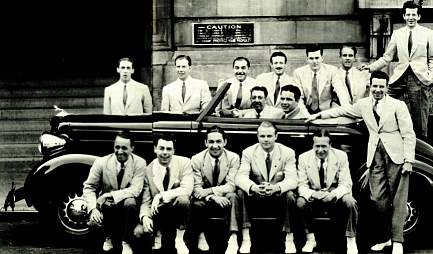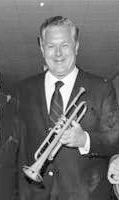The Bob Crosby Orchestra holds a singular place among bands of the Swing Era. While most swing bands were weighed down by dense orchestrations requiring the music to be ‘played as written’ rather than improvised, the Crosby ensemble maintained deep roots in the loose-jointed style of New Orleans jazz.
Today, Riverwalk Jazz pays tribute to the Bob Crosby Bob Cats, a smaller hot band within the Bob Crosby Orchestra. Founding member, bassist and arranger Bob Haggart joins us with piano legend Dick Hyman.

Bob Crosby & Bob Cats, 1937 photo Nat Shapiro; George Hoefer. From book, Pictorial History of Jazz by Orrin Keepnews and Bill Gauer, jr.
Many of the Bob Cats were native New Orleanians: guitarist Nappy Lamare, saxophonist Eddie Miller, clarinetist Irving Fazola and drummer Ray Bauduc all hailed from the Crescent City. With this core of New Orleans players, there was a strong emphasis on improvisation—coupled with a driving, rhythmic feel that proved popular among bobby-soxers and jitterbuggers of the late 1930s. At the height of their fame in 1939, the Bob Cats had their own half-hour weekly show on national radio called the Dixieland Music Shop, a segment of the Camel Caravan radio program. Their regularly featured guests were singer and songwriter Johnny Mercer and vocalist Helen Ward.
.jpg)
Portrait of Jack Teagarden, Dick Carey, Louis Armstrong, Bobby Hackett, Peanuts Hucko, Bob Haggart, and Sid Catlett, Town Hall, New York, N.Y., ca. July 1947. Photo by William Gottlieb. In public domain.
The Bob Cats and the larger Bob Crosby Orchestra operated as a team. Musical ideas came from everyone within the band—as opposed to the swing band standard, based on one strong-willed, charismatic leader who called the shots. In 1935 founding members of the Orchestra chose singer Bob Crosby (Bing's younger brother) to simply ‘front’ their band, leaving all musical decisions to be made solely by band members. Bob Haggart told author Richard Sudhalter, "Above all, we were like a family. We worked together, socialized together and musically thought together.”

Yank Lawson at The Landing.
The Jim Cullum Jazz Band has a special kinship with the Bob Crosby Orchestra. Jim Cullum counts Crosby band trumpeter Yank Lawson as one of his seminal influences. As a teenager with a growing affection for early jazz, Jim became part of the Crosby band’s extended family through his father’s friendship with its members. Like the Crosby ensemble, Jim and his band focus on preserving the rhythmic, improvisational feel of traditional New Orleans jazz while using an arranging style that combines formal, composed sections with plenty of room for group improvisation.

Dick Hyman photo courtesy of the artist.
On this radio show, Bob Haggart and Dick Hyman join The Jim Cullum Jazz Band on tunes made famous by the Crosby band at the height of its popularity, including mega-hits "Big Noise From Winnetka," "What's New?" and "My Inspiration" composed by Bob Haggart.
Pianists Hyman and John Sheridan play two-piano versions of "Hobson Street Blues" and "Eye Opener," both were showcase numbers for Bob Cats’ piano man Bob Zurke.
Photo credit for home page teaser image: Bob Haggart, composer and arranger for the Crosby band. Photo courtesy of the artist.
Text based on Riverwalk Jazz script by Margaret Moos Pick ©1990

